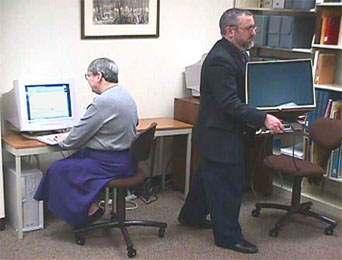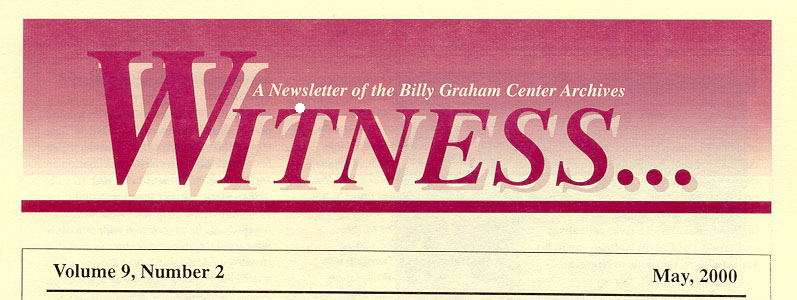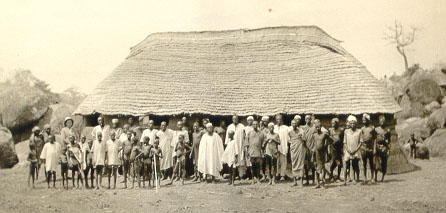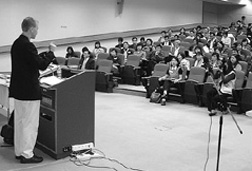

Forward Steps: Making the Archives Easier to Use

When the Archives first opened its doors in 1975, anyone who wanted to use our collections fingered their way through our catalog of typed 3 x 5 index cards. In 1985, the Archives, through assistance provided by Wheaton College’s Computer Services department, moved to a program on a mainframe computer into which the staff could enter brief descriptions of all its collections, along with the topics associated with each. The data in this program was used every three months to generate an alphabetical set of microfiche, which researchers would search to find what collections had information on a particular topic. And then, at the very end of 1999, we left our microfiche behind and went on-line, thanks to the work done on behalf of the Archives by Wheaton College computer science professor John Hayward.
Researchers now have available to them anywhere on earth, via the World Wide Web, the same database that they can use in the Archives’ Reading Room in the Center building in Wheaton, Illinois. Through this database (located at http://abigail.wheaton.edu/archives) people can find for themselves, without going through the Archives staff, all the processed collections in the Archives that have information on a particular topic. That topic might be the proper name of a person, place, organization or event as well as a more general subject. If someone wanted to know, for example, if there was any information in the Archives on Christian missions to Japan, he or she would type in “Missions--Japan” and hit the search button. Soon the user has a list of brief descriptions of twenty-five different collections with relevant information - private papers of missionaries, oral history interviews with Christian workers, files of organizations, proceedings of conferences, etc. To the right of each individual collection description on the list is the number of that collection. When the user clicks on that number, he or she goes via the Internet to the full length guide which describes the contents of that particular collection in detail.
The user can shape and define the search in various ways. For example, if he or she is only interested in photos of evangelistic congresses, a search can be done that will produce only collections with that kind of image. A site linked to the database page provides suggestions for doing profitable searches. It also contains yet another link to a list of all the subjects in the database. Anyone having trouble finding the right term can check this list for other possibilities. The topics on the database are in Library of Congress format, with some modifications. Work in an archives is always more labor intensive than working in a library, let alone surfing over the Web. So an enduring goal of our staff is, in small ways and large, to make it easier for our patrons to both discover the riches the Archives has and to use them. Our new on-line database is another of our steps toward that goal.
Another kind of step was taken in February. Whenever possible, we are attempting to microfilm our more heavily used collections so that the microfilm copy can be borrowed through inter-library loan. (Microfilming also reduces wear and tear on the original documents, and so helps preserve them.) In this way a researcher working through his university in Portland, Maine, or public library in Portland, Oregon, can use documents from the Archives without ever crossing our threshold in Wheaton, Illinois. Our most heavily used collection is number 81, the records of Africa Inland Mission. The first two boxes of this collection consist of minutes and reports from AIM governing boards and committees in the United States, Australia, the Congo, England, Kenya, Tanzania, Uganda, and many other countries. Most of the material is from the 1950s and 1960s, but some documents are as old as 1932 or as recent as 1986. The records on microfilm provide solid documentation of AIM’s work in east central Africa, the development of the Africa Inland Church, and the larger topic of Christianity in Africa during the middle of the twentieth century. The entire collection, as of May 2000, consists of ninety-three boxes, so we have only begun the process of filming, but we hope one day to have the entire collection available on microfilm and in other formats.
*****

A 1936 photo of the church started by the Sudan Interior
Mission in Gure, Nigeria. From Collection 202.
“Research in the Archives”
Here are brief descriptions of two projects that brought people to the Archives recently to grapple with our documents, as well as their comments on the experience:
Joel Carpenter, well known historian of American Evangelicalism and provost of Calvin College, spent his visit studying missions to Nigeria. It was cold outside, but my historical imagination was dwelling in a very warm place, northern Nigeria. I listened to two retired missionaries reminiscing about their combined 75 years of service in and around the city of Kano. I came to the BGC Archives because I was able to find out, via searches on its web site, that it holds important resources on the history of the Sudan Interior Mission (SIM), its work in Nigeria, and the rise of the Evangelical Church of West Africa out of the SIM efforts.... I came looking for a closely grained picture of the missionary experience and for a deeper understanding of the cross-cultural encounters between missionaries and the people of Nigeria. What I found was very satisfying in that regard. Oral histories, despite their obvious limitations, are superb windows into frontline experience of the past. They are also more candid, in most cases, than published memoirs. The most surprising thing I found was the deep tension the missionaries felt in their relationship with British colonial officials. The recent articles on British colonialism in northern Nigeria by Andrew Barnes of Arizona State University prepared me for this encounter, but it is still shocking, a half-century later, to hear how deeply racist the British colonial officers were.... SIM missionaries would insist that they had no political agendas whatsoever, and that their task was simply to preach the Gospel and guide the growth of new churches and church leaders. In most cases they eagerly sought the good graces of the British officials. Yet the way to people’s hearts, they learned, was through expressions of Christian love. Gospel witness and obedience to the worldly powers came into conflict, and those missionaries who succeeded in winning the hearts of their Nigerian brothers and sisters often engaged in some modest acts of civil disobedience. Simply offering a Nigerian a seat in one’s office, or serving area pastors tea in one’s “company china” became quiet acts of anticolonial defiance.
Camille Kaminski Lewis, Ph. D. candidate at Indiana University, Bloomington, came to study twentieth-century American Evangelical rhetoric: Religious separatism in general is not simply concerned with identifying with the divine — if it were, then, it would completely remove itself from the view of the dominant. Instead separatists leave the table but remain within the gaze of the mainstream.... They prove their worth by mastering the cultural ideals. They become, in a sense, irresistibly attractive. The Amish, for instance, while clearly setting sectarian boundaries in clothing and customs, attract the mainstream by embodying prosperity and frugality.... In conference papers I have analyzed the separatist rhetoric of Malcolm X and the antebellum evangelical women’s magazine Mother’s Magazine using this “attraction” metaphor. In my dissertation, I intend to use the same method to unpack the rhetoric of early fundamentalists.
Since I was able to cull relevant sources from the BGC Archives’ web site, I knew what primary sources the Archives offered. I had already pinpointed the files I wanted to peruse. So there were few surprises for me in acquiring the sources themselves. However, as I examined the files, I was amazed at the scope within them. Everything from scrapbooks and court transcripts to musical scores and sermon notes - I never expected to find so much. Fundamentalism continues to be a fertile academic topic. Many scholars point up the fundamentalist contradictions as they separate from a culture that they seem to be embracing, but few scholars attempt to explain this tension. This “attraction” metaphor may explain seeming inconsistencies in fundamentalism while speaking to larger analyses of other religious sectarians.

During its first twenty-five years, the staff of BGC Archives has focused a major portion of its energy on building its collection. But even for the small slice of Christian history that we have set out to document, we can gather only a representative sample. We therefore welcome the chance to help develop a network of archives which tell the story of the spread of the gospel. A case in point is our work with Hong Kong Baptist University’s Archives of Christianity in China (hereafter referred to as ACC).
The link began in 1998 with our gift of tinted glass lantern slides of missions in China to the University. As reported in the May 1999 issue of Witness, HKBU librarian Irene Wong did an internship in Wheaton in preparation to becoming archivist of the ACC collection. Then, in February, Associate Director Paul Ericksen traveled to Hong Kong in response to a request from HKBU for someone from our archives to visit the ACC to help evaluate and advise their program.
What Ericksen found was an archives of Chinese Christian documents consisting of rare books and purchased microfilm (such as the China portion of the American Board of Commissioners for Foreign Missions records), but which was already acquiring its first collection of private papers from a retired missionary to China and Hong Kong. Wong is now finalizing the much-needed collection policy for the ACC. BGC Archives Director Robert Shuster commented that, East Asia has few archives which tell the story of Christianity in China. By its activity and its example the ACC can make a major contribution to preserving and making available, especially for the use of the church, the documents of the spread of the gospel in China and to encourage others to begin collecting as well .
Ericksen also used the occasion of his visit to encourage other Christian archives in Hong Kong, through events hosted by the HKBU Library. He led an all-day seminar (above) on developing a simple congregational archives, which was attended by 155 participants, with translation provided by Wong. It is on the web at www2.wheaton.edu/bgc/archives/chaw.htm Ericksen observed, The most often cited issue confronting the development of any archives in Hong Kong, but especially a church archives, was the absence (translate as “high cost”) of space, which for the storage of collections is essential. However, the enthusiasm indicated by the attendance at the workshop was matched by questions which revealed a growing understanding of archives theory, recognition of the implications of these for archival practice in the Hong Kong context, and a determination to find workable solutions.
He also gave two lectures. One, to a group of over fifty including historians, archivists, university students and church leaders, was on the methods of oral history and its use as a research tool. The other was a lecture, featuring material from the BGC Archives, on China Inland Mission’s evacuation from China in 1951.
After visiting, with other archivists, the Public Record Office and the Catholic diocesan archives, Ericksen concluded, In the several archives in the city and the young Hong Kong Archives Society, there is present a commitment to provide direction and assistance to what we hope will soon be a growing group of church archives which will join the ranks of those who help to instruct, encourage and warn the Christian community in Hong Kong.
When the Communists took over [in Xian province in China, ca. 1949], they had a conference up in Xian. Every church had to send representatives.... They had a speaker from Peking in the Religious Affairs Bureau..... And he preached to the them the Three Selfs. “You must be self-propagating....” When it was over our leader said, “We’ve done that for years.” “Well, who does all your evangelistic work?” “We do.” “What do the missionaries do?” “What we ask them to do. They teach. We want to have conferences, Bible schools, and they’d do what we ask them to do....” Then it had to be self-governing. And the same thing happened. And when he’d finished... they let him (typical Chinese, polite) . . . harangue on for an hour or two and when he got all finished, they said, “We’ve done that. We’ve been in control of our churches for years.” “Well, when you have a meeting, who chairs the meeting?” “We do.” “Well, what do the missionaries do?” “They only come when we invite them, when we need advice, we need help.” “Well, who runs the church?” “We do.” Then it came to self-supporting and the guy from Peking really got the shock of his life, ‘cause he thought he had them there. And when he finished he was the only one that was supported with foreign funds, YMCA [the Young Men’s Christian Association].
Excerpt from Collection 470, an interview with Sadie Custer, an Overseas Missionary Fellowship (CIM) worker in China, Malaysia and Taiwan from 1936 until 1976. Her collection is now open to researchers.
Guides to all the collections mentioned in this newsletter can be found on the World Wide Web at the Archives' home page.
The address (or URL) for a list of collection guides in collection number order is: http://www2.wheaton.edu/bgc/archives/guides/g1.htm
The address for a list of collection guides in alphabetical order, according to the name of the creator of the documents, is: http://www2.wheaton.edu/bgc/archives/guides/g2.htm
Back to Table of Contents
*****